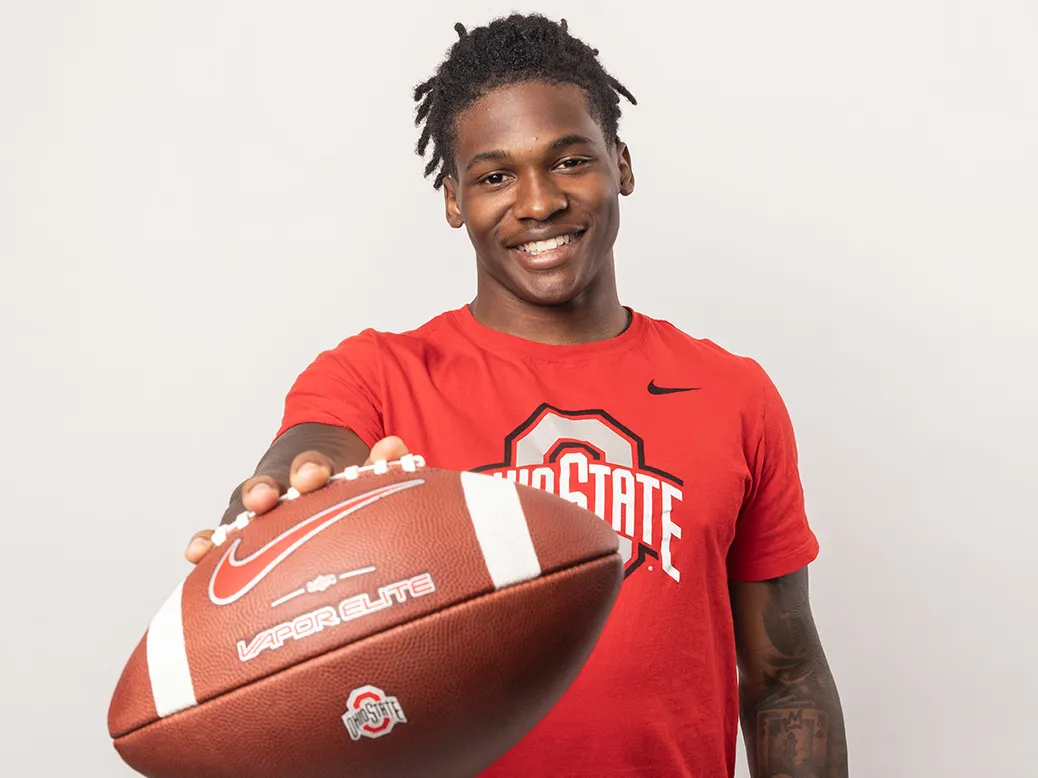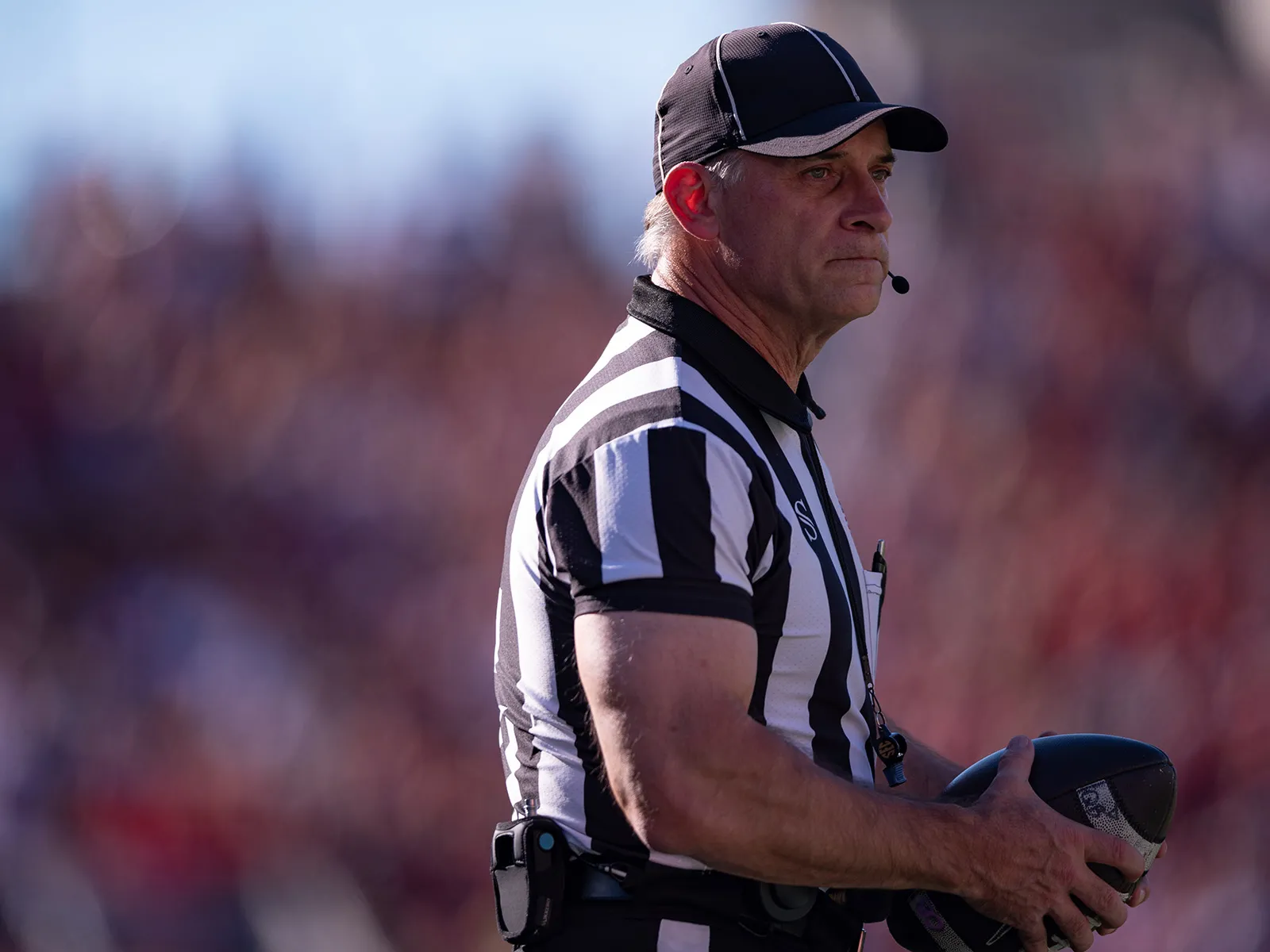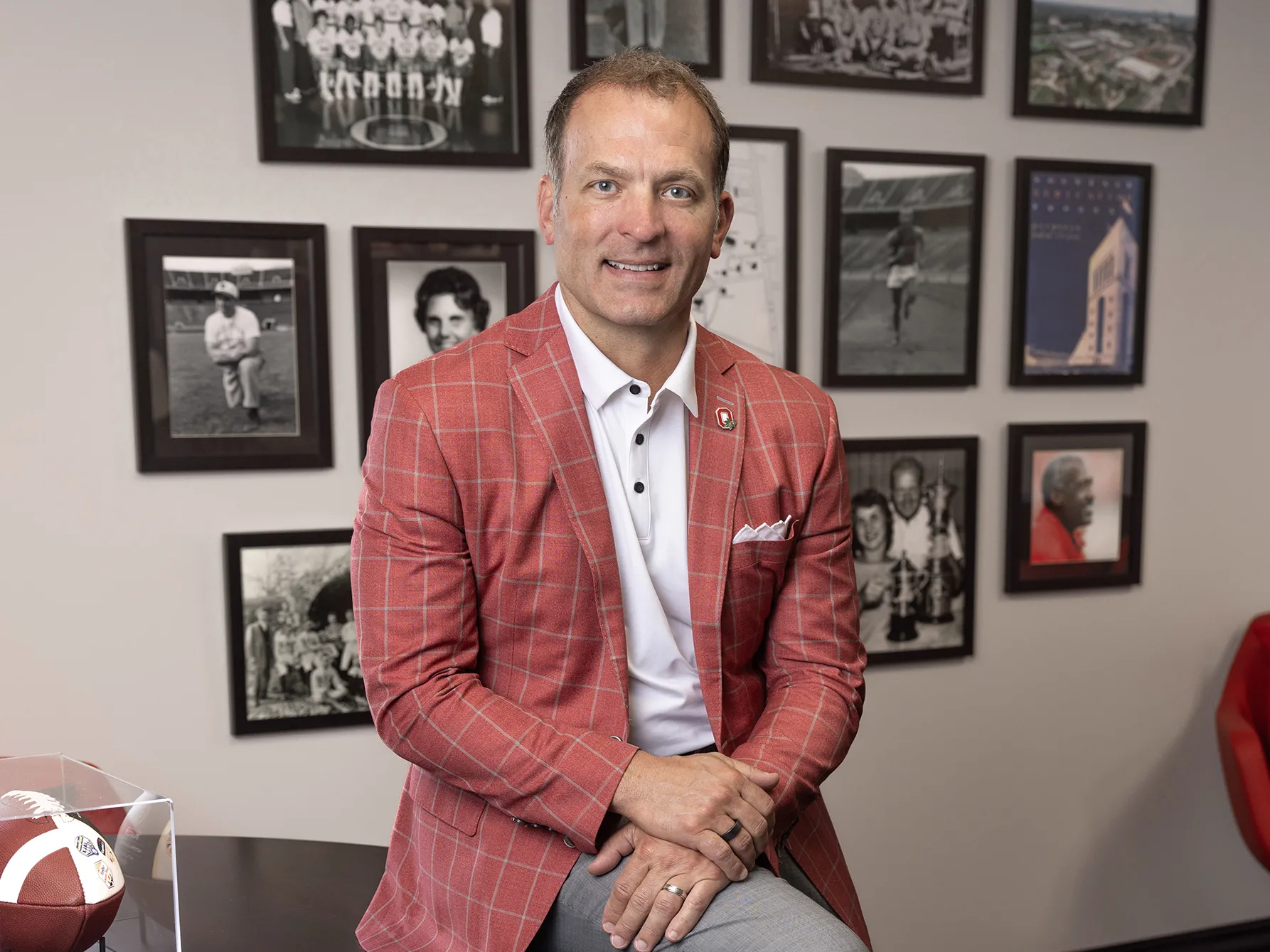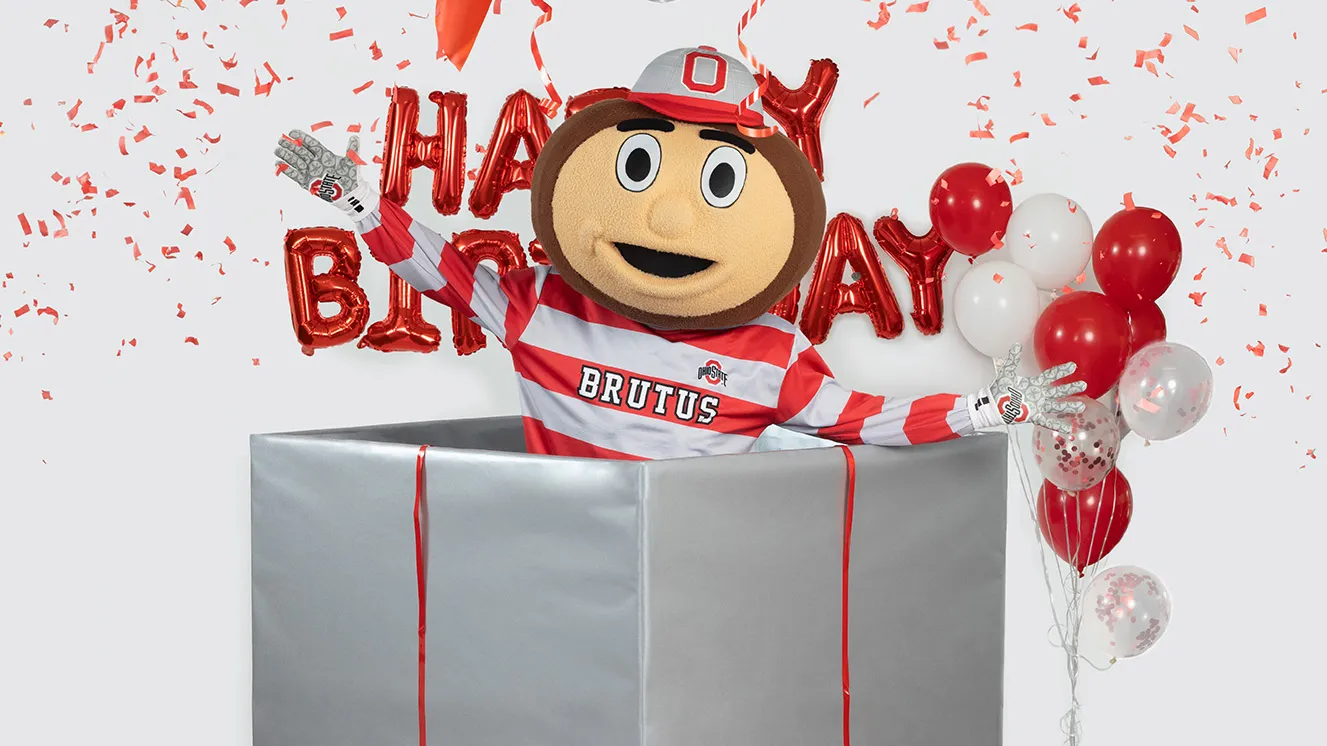
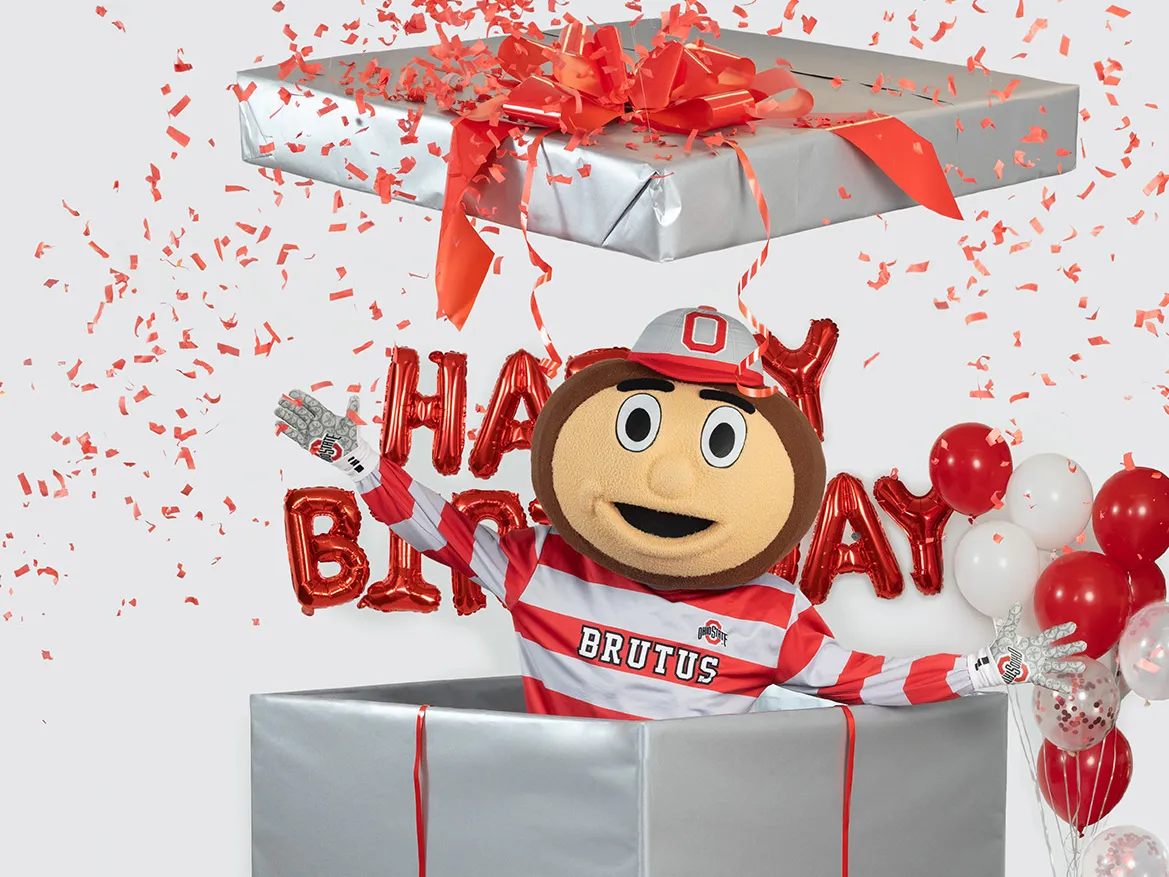
Being Brutus Buckeye
Sixty years ago this month, our beloved mascot was born. We celebrate the milestone with an oral history from the anonymous heroes who’ve worn the colossal head.
The physical appearance of Brutus Buckeye has changed a great deal over the past six decades, but not the heart and humanity of the students who’ve worn the costume. They’ve been on hand for nearly every major Ohio State event and have some amazing stories to tell. We’ve gathered those stories—many never before shared—from more than 50 individuals who have worn the head of Brutus over the decades.
“The costume is just foam and fabric,” says Brutus Coach Ray Sharp ’13, who served as Brutus from 2010 to the year he graduated. “It’s the students inside that costume who bring our mascot to life and have made him the iconic figure that he is today.”
Keith Burkes, one of the last to wear the original “big head,” expanded Brutus’ role beyond just football games by traveling to schools and community events, becoming a spirited ambassador for the university and the state of Ohio. Today, Brutus makes more than 500 appearances a year at nonsporting events.
Mary Burnett Brown ’83, who served as Brutus in 1981, wore the first version of the modern, smaller head. She also created what might be Brutus’ first “kindness campaign,” by handing out Dum-Dum lollipops, made by a company in her hometown of Bryan, Ohio.
As one of Brutus’ co-creators, Sally Lanyon ’67 has seen his power to move and connect people. Once on a flight, she met a teacher from Indian Springs Elementary in Columbus who invited her to speak to their class. Lanyon created a play to show the students how Brutus was first imagined and brought to life. (Ray Bourhis ’66 was the other co-creator.) Her visit left such an impression that the class created a book for Lanyon, capturing their special day together. On the mascot’s 50th anniversary in 2015, she started “The Brutus Blog” to capture and share more stories from those who brought the mascot to life.
In October of this year, Brutus turns 60, and we celebrate not just a mascot but a movement—one that continues to embody joy, spirit, tradition and the enduring power of Buckeye pride.
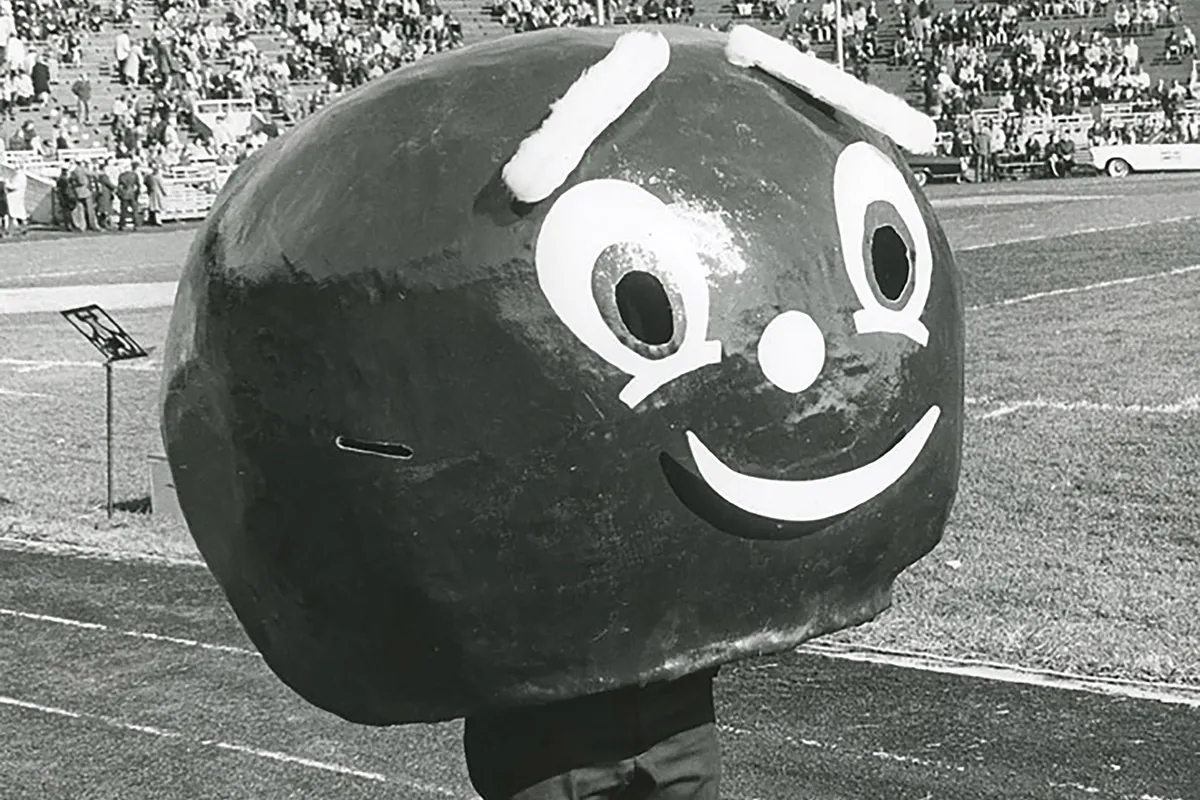
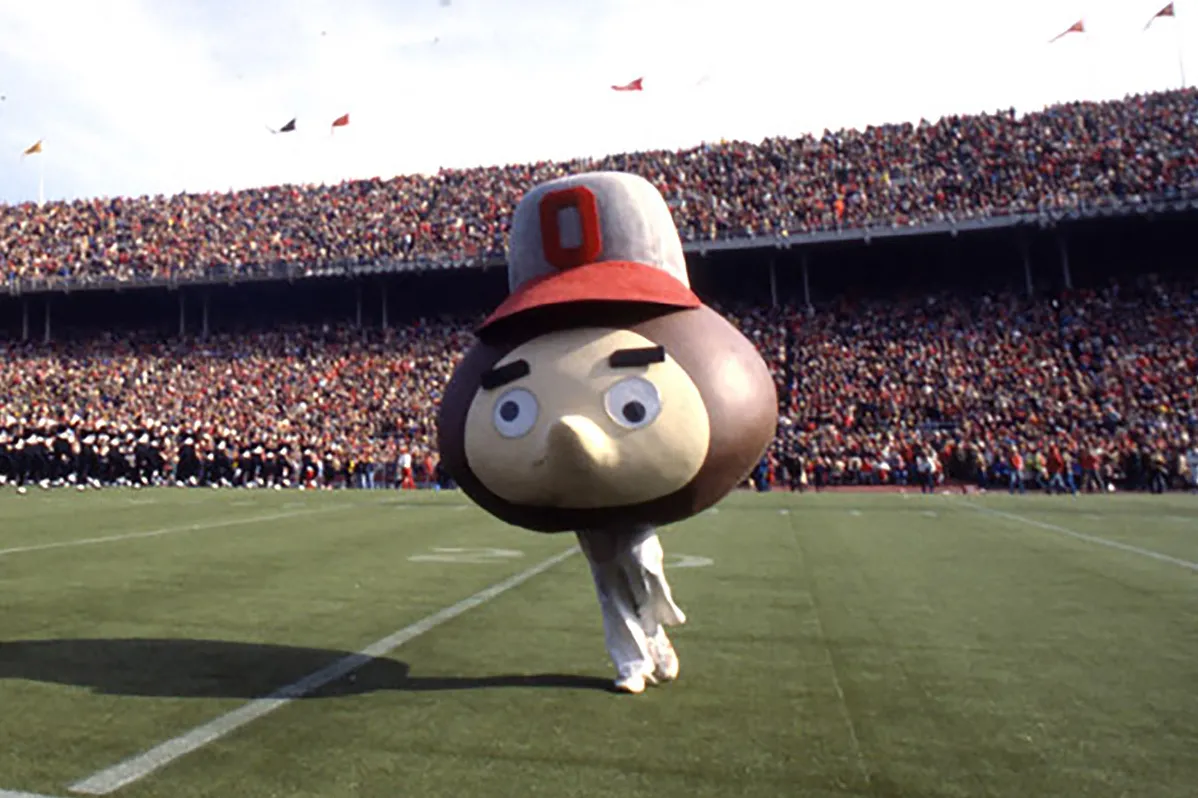
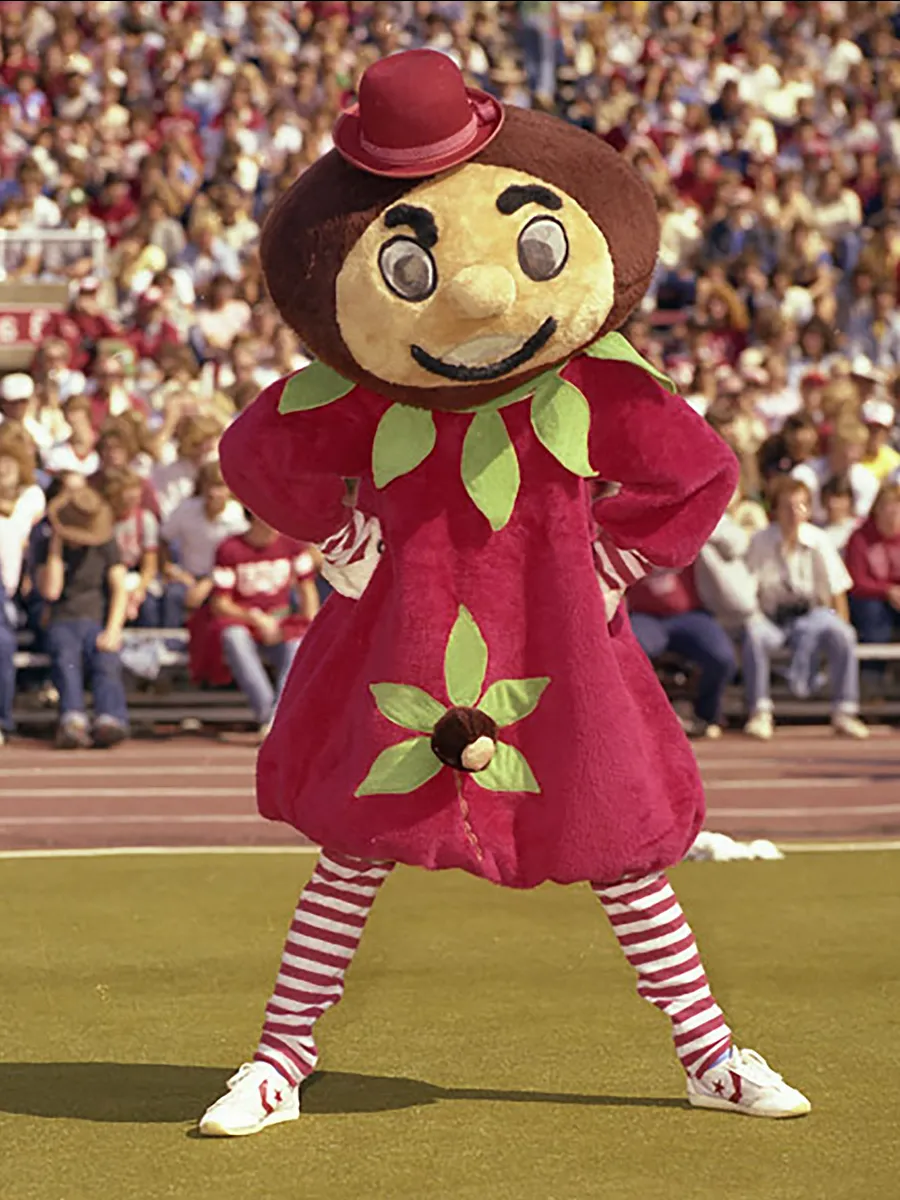
Brutus through the years: 1981 (Photos from University Archives)
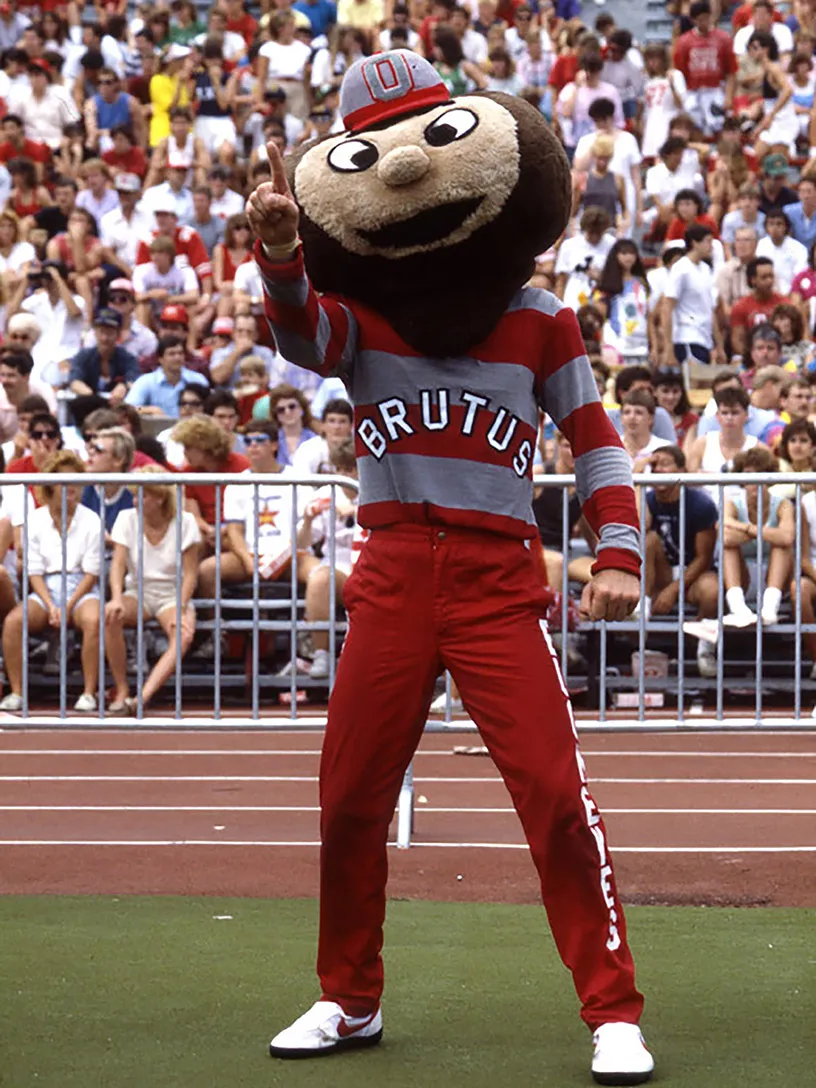
Brutus through the years: 1986 (Photos from University Archives)
Becoming Brutus
In the early years, students seemingly became Brutus at random. An off-hand suggestion, arbitrary encounter or even a fortuitous bet might lead them to play the role. But as our mascot’s profile rose on campus, motivations to become Brutus grew more meaningful.
x
Alastair “Sudzy” Steyn, 2013–15: I could see how people looked at Brutus on campus and all the things that Brutus was able to go and do. And then I got to know the individuals who were Brutus outside the uniform, and they were all such great people, and I loved that camaraderie they had, and I wanted to be a part of it.
Alan Babinec, ’14–’17: My mom was in the marching band, and I grew up in a household of her screaming at the TV during football games. As a child, I started dressing up like a little mini-Brutus. I was doing fake little mini-Brutus appearances with the alumni band going around Cleveland. I even made Cleveland news. And so it was my mom who said, “You should try the real thing.”
Emily Moor Williams, ’01–’03: The person inside Brutus is usually a guy, but you never know unless you try. So I tried out, made it, and it really, really changed my life. One of the highlights was being Brutus for the 2002 National Championship football game.
I am proud that I just started a Brutus endowment so no one ever has to wonder if they should give up on being Brutus because they can’t afford it.
Nathan Chaykowski, ’22–’24: My dad works for Ohio State. I was already a huge fan, and there’s no bigger fan than Brutus Buckeye. To be an athlete, support my team and just make people’s day was perfect for who I am and for me to help Brutus grow. Rumor has it my dad cried when he first saw me run out at a football game, and he is not an emotional guy.
x
Today, family traditions even inspire some to sign up. The Steyns—Sudzy, Trevor ’17–’19 and Patrick ’21–’23—are the first brothers to serve as Brutus, while the Congroves—Doug ’90–’92 and Max ’21–’22—are the first father-son mascots.
x
Sudzy Steyn: Being able to share it with your brothers is so special. It’s hard to put into words. I remember them trying out and showing up at their tryouts and then thinking about my tryout and coming back to my house and running through skit ideas and how could you do this differently or this move or what could you do here if this happens? And we even come up with family improv games sometimes when we’re all together. It’s a hard experience to understand unless you’ve done it. But since we’ve all had the experience, we can. We get it.
Max Congrove: Dad and I got to share some special moments at the stadium, especially when we had a bunch of extended family there. I got to remake some of the same memories they had when Dad was in costume.
Doug Congrove: I had more enjoyment watching Max perform than doing it myself.
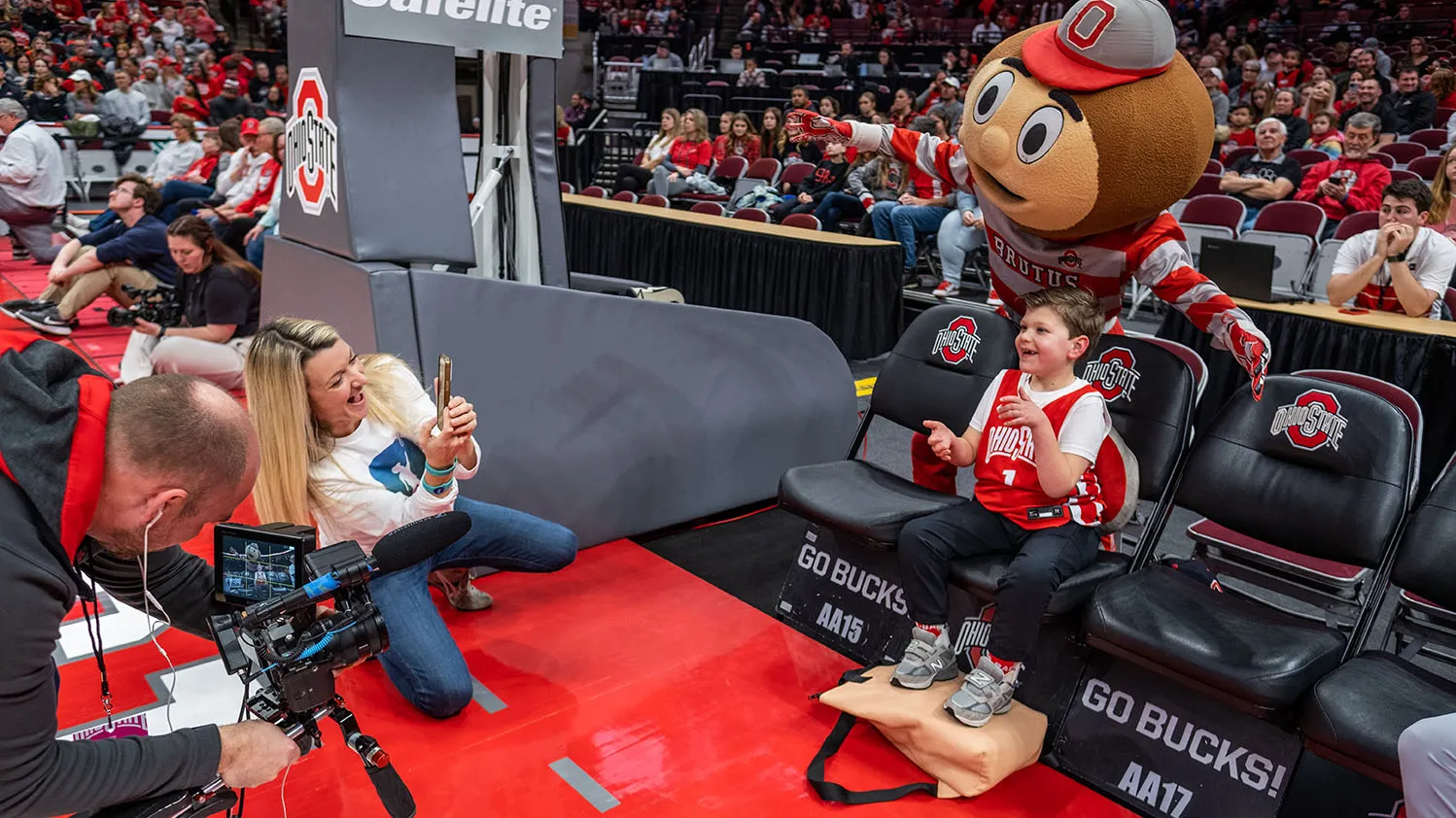
Brutus poses with 6-year-old Landon McChesney, who has a rare genetic disorder caused by a mutation in the TBCD gene, at a women’s basketball game in 2023. (Photo by Corey Wilson)
Brute force for good
Even though altruism is in the DNA of Brutus, the mascot was limited at first by the nature of his costume. His bulky fiberglass head couldn’t fit on a bus or through most doorways. But in the early ’80s, that began to change, thanks to the dawn of the “small head” era, multiple students at once playing the role of Brutus, and the leadership of cheerleading coach Judy Bunting ’74, who expanded the mascot’s charitable mission.
x
Brian Bunting, ’06–’10: My mom very much believed in what Woody said: “You win with people.” She took that as her guiding principle. If somebody wanted Brutus or the cheerleaders at their events, she would figure out how to make it happen.
Chris Howard, ’10–’14: Brutus is a year-round gig, and there’s no offseason. Sports only account for a small fraction of the time we spend in costume. As great and exciting as the sports events are, the majority of our time is spent in community service and campus events. You can know someone’s values and what’s important to them by how they spend their time, and I would say that answers the question of how important service is to the Brutus program.
Duncan MacKenzie, ’18–’22: I really think of Brutus as the ultimate activity that you can do at Ohio State. You get to be a part of literally hundreds of organizations on and around campus.
x
Inevitably, as they become more ingrained in the role, Bruti realize community interactions are the essence of the mascot’s character. In particular, many speak movingly of their experiences at hospitals.
x
Brian Bunting: We did a hospital visit, and it was at The James. My mom knew my schedule and said, “Hey, we’ve been asked to go meet this family that just found out that one of the family members was diagnosed with cancer. Can you be Brutus in 10 minutes?” It was my busy day in terms of class load, so I was a little bummed about missing lunch.
But the second you get in costume and you get upstairs into these rooms and you just see these huge smiles on people’s faces, that’s really impactful. And I think that changed my perspective. I knew what the character meant, what Brutus means to people. But it changes how you view some of these seemingly small and insignificant events. They really are impactful to the people that you’re with.
Jeremy Hitchens, ’13–’15: We went to [Ohio State East Hospital], and we’re doing rounds, seeing patients, and we walked past this room on our way out, and this lady comes out. She says, “Hey, my dad is a huge Ohio State fan. He’s never met Brutus. Would you guys stop in?” And we’re like, “Yeah, of course.” We walk in there, and the guy says, “Brutus Buckeye.” And that’s all he says. We don’t think anything of it. Well, the daughter starts crying. There are a couple other family members in there, too. They start crying. She walks out with us and says, “My dad’s been on his death bed for two weeks and hasn’t said a single word in those two weeks. His first words were ‘Brutus Buckeye.’”
Break a record for Brutus
Celebrate our favorite mascot’s 60th birthday with an attempt to set a Guinness World Record for the most people wearing the same hat. Join the fun at 5:30 p.m. Oct. 29 in the south stands of Ohio Stadium.
Jamie Cleverley, ’96–’99: There was this kid who was struggling with cancer, fighting for life, and his Make-A-Wish was to meet Brutus. I remember walking into the room, and he hid underneath his hospital sheet for a few minutes. He was just sensitive, scared a little bit.
So I backed in a corner and got quiet and reserved, too. And his family joked, “Oh, Brutus is nervous as well.” And he warmed up. We then spent probably what was about an hour without any words at all, going back and forth, playing games, figuring out little things to do. It was beautiful. But the best part of this story is I leave, and my heart is broken because I’m thinking this little guy has got to go back to treatments and everything else. Three months later, I get a call, and they say, “Hey, can you come back out? But not to the hospital. Can you come to our house?” The little guy was cleared, got into full remission, and I got to go play with him on his front lawn.
Mike George, ’14–’17: The games and the glory and the athletics—that’s not what makes a good Brutus. What makes a good Brutus is how people can be in community-service and personal situations. Brutus needs to be at BuckeyeThon. Brutus needs to be at hospitals. Brutus needs to go to those Make-A-Wish events. Brutus belongs to the state of Ohio, and he should be out in the community showing everybody that.
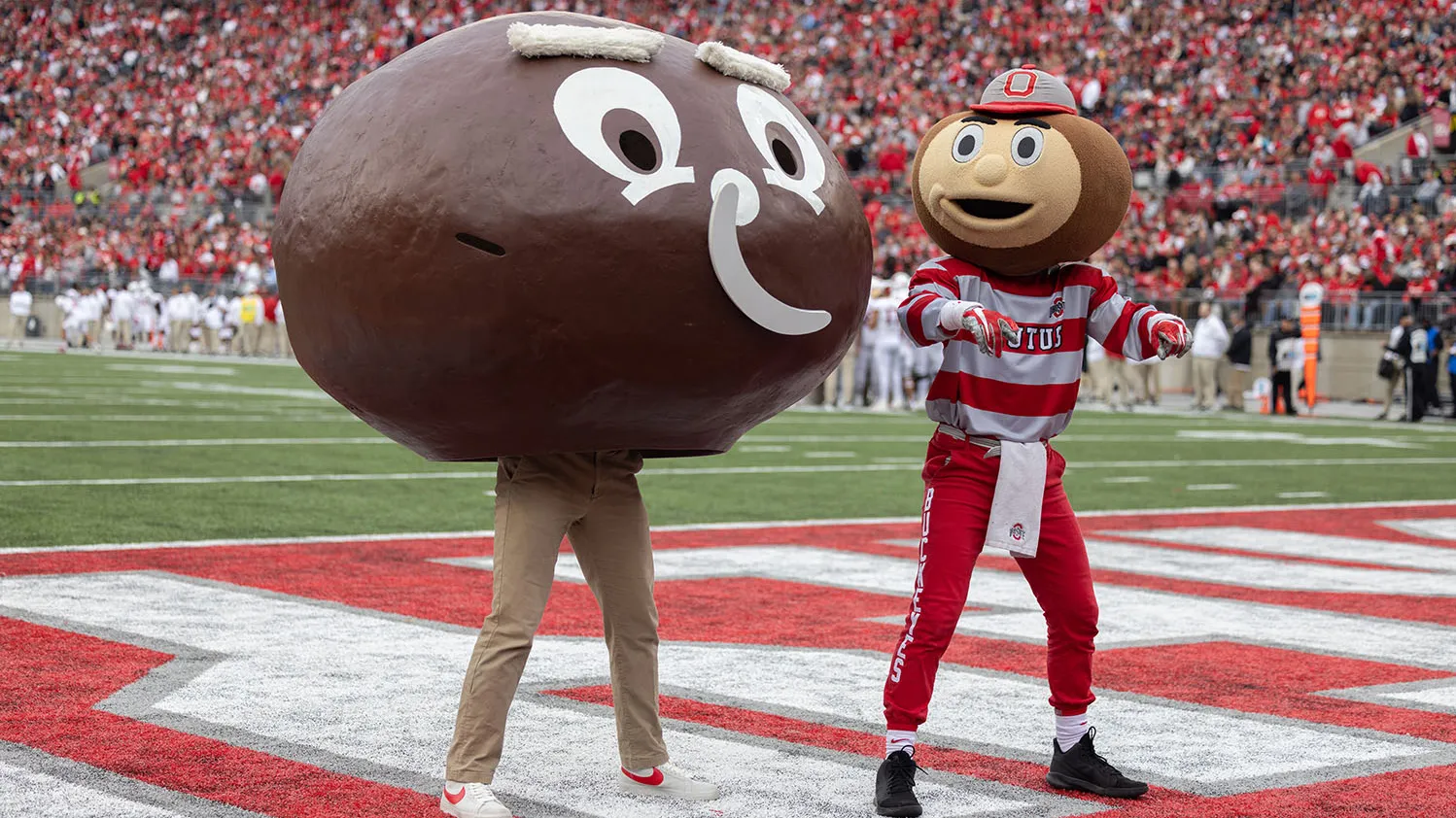
Brutus leads a cheer with a vintage Brutus during the Rutgers game at Ohio Stadium in 2022. (Photo from University Archives)
The life of a nut
Brutus has lived a colorful life, one defined by awkward stages, celebrity encounters, in-the-moment innovations and a surprising (and ever-expanding) set of skills. Various Bruti have brought their unique talents to the role: drumming, piano-playing, acrobatics, ice-skating, the inchworm and more. But some of the most attention-grabbing moments have occurred when Brutus has shown his football prowess.
x
Mario Nedelkoski, ’94–’97: I caught a pass from Peyton Manning at the Citrus Bowl in ’96. It rained and rained, and I caught the pass that Shawn Springs and a couple of Tennessee receivers missed. I get taken out by three players. But I held on, stood up, spiked it, did the Heisman pose. Our section went crazy. And as I’m walking in the locker room, Brent Musburger, during halftime, comes in, and goes, “Hey, Brutus, is John Cooper gonna offer you a job? Cause nobody else can catch the ball today.” It was so funny.
Ante-Tonci Dejanovic, ’18–’20: I played soccer as a kid, and I did do some kicking in high school. I actually did try out as a kicker for OSU. But I couldn’t continue to try out because of school. It was a huge dedication. So what better way than to use it as Brutus, right?
I got in Sports Illustrated for kicking field goals. I was practicing on Friday, and so the Big Ten media was in there getting ready, and one of the Big Ten guys started to record me—“All right, Brutus, come on, let’s see it.” I went and hit some 50-yard field goals right there, and that’s kind of how it went really viral, which was so fun.
x
Bruti have a seemingly endless supply of funny and remarkable stories. It comes with the territory. When you dress like a humanoid horse chestnut in public, you’re bound to have a few tales to tell.
x
Nedelkoski: The first time Lee Corso put the Brutus head on was my Brutus head. [Also the beginning of the “College GameDay” mascot head tradition.] That was 1996. Allison, Kirk Herbstreit’s wife, was there. She was a cheerleader. Her last year was my first year. And she comes up and goes, “Mario, Mario. Lee Corso wants to borrow your head.” I said, “We don’t do that. Mascots never take their heads off. No chance.” So it took a little coaxing. I go, “The only way I’ll do it is if I can hide somewhere.” So I went under the table, and then I took the head off and handed it to him from under the table.
Cleverley: Judy [the cheerleading coach] was on the fence. But then she was, “All right, go ahead, give him the head.” And look what it became.
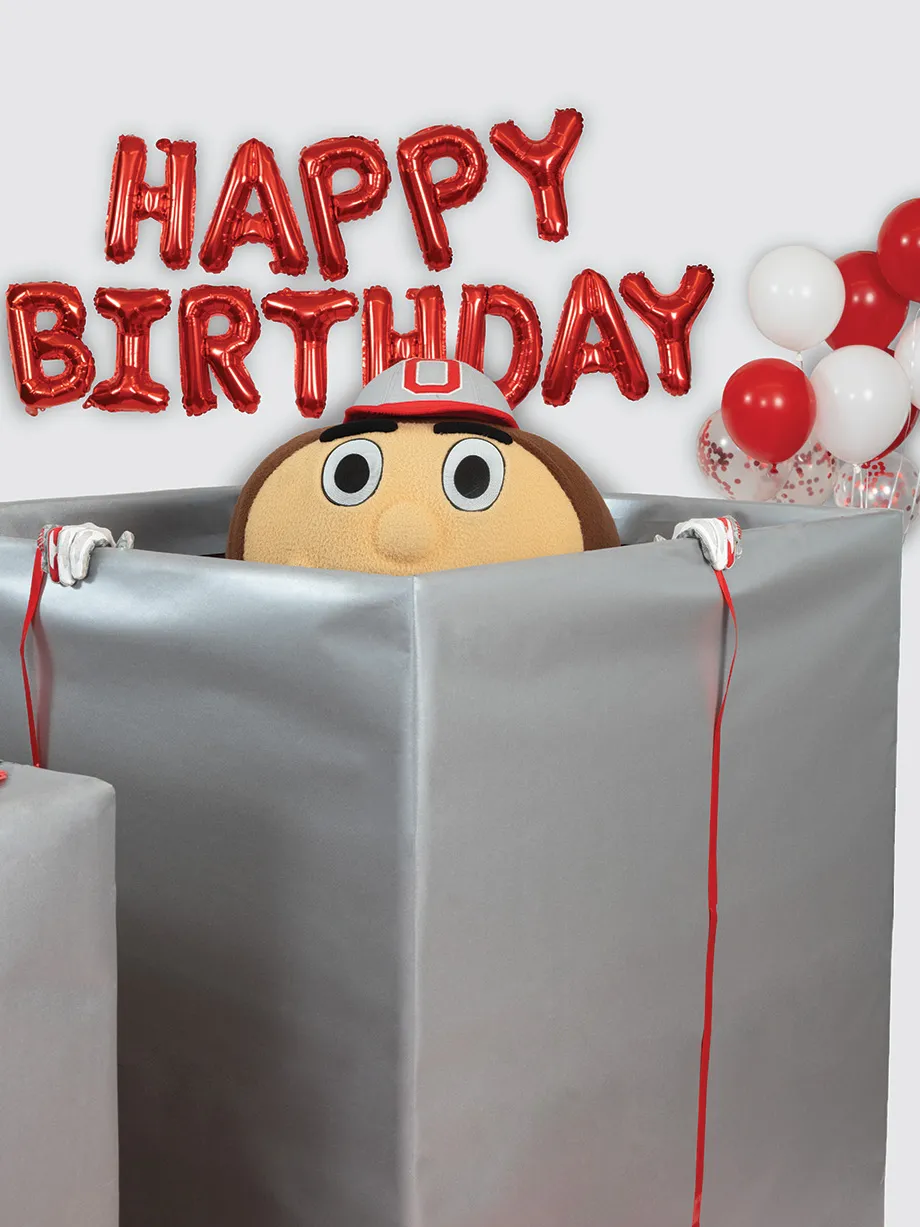
(Photos by Jodi Miller)
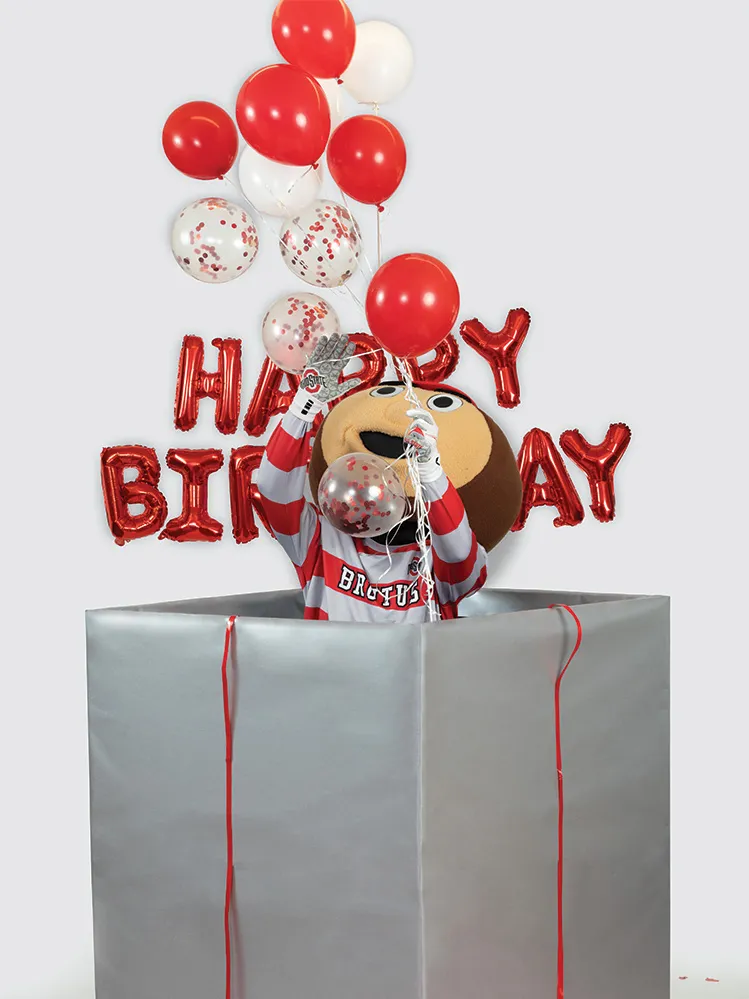
(Photos by Jodi Miller)
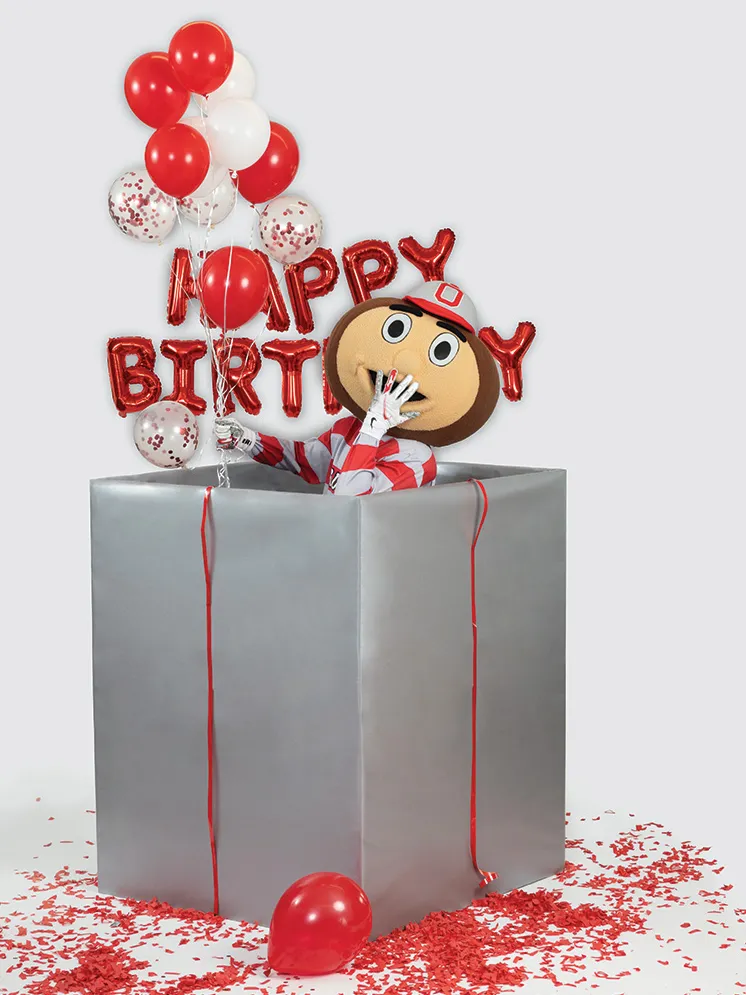
(Photos by Jodi Miller)
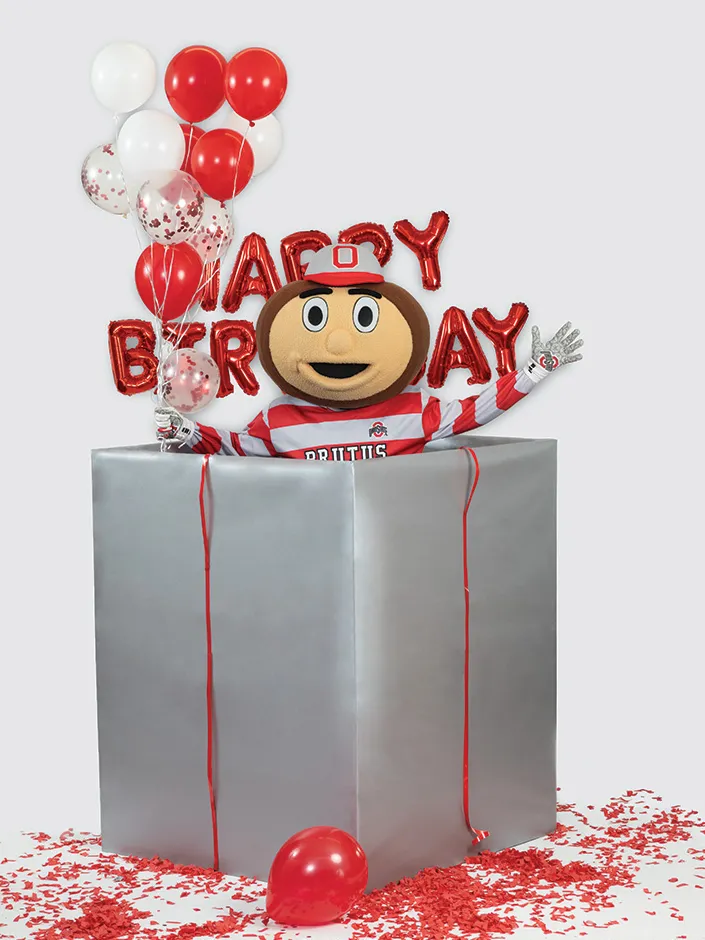
(Photos by Jodi Miller)
Hitchens: My first event was a funny story. We went to one of the Dublin schools. I thought it was just going to be a bunch of classrooms. That’s not what it was at all. It was like a huge fair with kids from every single age and families. As soon as we walked in, this little girl came up to me, asked to take a photo and so I did. And then she turned around and looked up to me, and she’s like, “Thank you so much.” And I said, “You’re welcome.” As you know, we’re not supposed to talk. But I was so taken aback by the whole thing and was so excited that she wanted to take a picture with me.
Tim Daly, ’92–’95: We were playing at Indiana. It was a late-night game. It had been raining, really wet. I was just exhausted. And when I get on the bus, the only seat available on the entire bus is next to Archie Griffin. Now, I’d met him in the summer. So he gets a big smile on his face. “Come on, Brutus.” He scoots over, and I sit down next to him, and I reach into my coat pocket, and I remember I had two granola bars. And I looked at him and said, “You want a granola bar?” And he goes, “Yeah, it’d be great.”
The next thing I know, I fell asleep on his shoulder. The entire ride to the airport, I slept on his shoulder. He nudges me when we get to the airport, and he goes, “Hey, hey, Brutus, we’re here.” I’m like, “Oh, my God.” I’m so embarrassed. I’m just looking to make sure I hadn’t slobbered on him or something.
Cleverley: I did an event at the vet school, and they were like, “Oh Brutus, come on over. Do you want to palpate this cow?” And I was like, palpate the cow? I had no idea what that was. I’m like, sure, I’ll do it. Then they show me this giant plastic glove, and I start to realize what I’m going to have to do. They’re like, “Yeah, you can check for pregnancy here and do this.” No idea what it was before and don’t want to have that experience again.
Will Moddeman, ’22–’24: I woke up to a fire in my apartment. You always think, “Oh, what would be the first thing I grab in a fire?” For me, it was the Brutus head. It was an instinct almost.
I brought it downstairs, and it was sitting on the stairs when I ran outside to look at the house. The fire department had showed up and wouldn’t let me back in. I was like, “I need to get the Brutus head.” One of the firefighters had actually walked into the house. He pulled Brutus’ head out, took it to the fire truck and kept it there safely as they went back in to put out the fire.
One of my teammates and Coach Ray were there immediately to see if I needed anything. It’s definitely a supportive group when you join the Brutus team. They all had my back. And I knew I was gonna be fine with all the support they offered me.
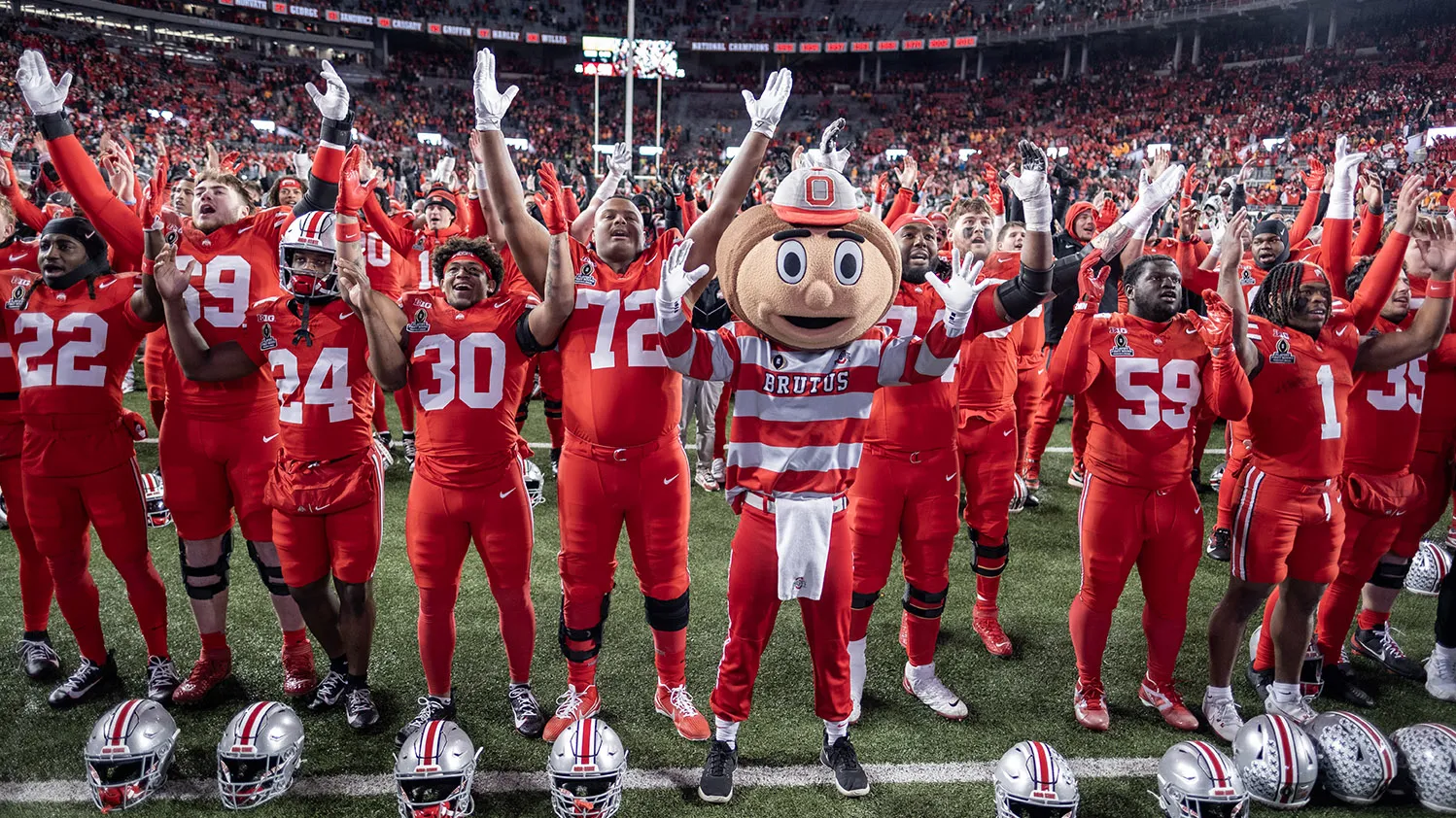
Brutus leads the football team in singing “Carmen Ohio” after a game in 2024. (Photo by Corey Wilson)
Brutus forever
Some former mascots are now pilots. Others are in the military. Many have gone into health care. One even found a second calling as another iconic figure dressed in red. And all carry their Brutus experiences with them, applying the skills, values and connections they gained in costume in their current lives and careers.
x
Matthew Stierhoff, ’12–’15: I would never be a pilot if it weren’t for Brutus. Jeremy Hitchens, my old teammate, his dad, John, was a pilot for American. When I was working in Columbus for a bank, I didn’t love it. I think there’s just something about the personality of us former Bruti. We can’t sit still, really. We can’t do a typical 9 to 5, sitting at a desk. Jeremy’s dad, John, said there was a cadet program they were starting up and a pilot shortage, and you guys should really look into it. I guess we have a type. Excitement, I think, draws us.
Tyler Fortman, ’05–’07: Being Brutus really asks you to pay close attention to what’s happening around you and the dynamics around you, even how somebody is responding to you. That’s not so different than psychologists like me. We’re constantly looking at, what is going on for that person individually? How does it fit into the system around them? And then we respond to it. And Brutus is doing something that’s similar.
Brian Bunting: People who know me never thought I would be Brutus. I’m normally a shy person, but it really did help me build a level of confidence and take command of what I do and how I act. Then going into leading a platoon in the military eventually and being a leader—I think Brutus definitely helped me put myself out there in ways that I don’t think I would have done otherwise.
Scott Geyer, ’85–’86: I’ve become the Santa Claus for Toys for Tots here in the city of Columbus. I do Santa for the Franklin Park Conservatory. Universal between Brutus and Santa is you are the epitome of love in a simple form. And whether you are 8 months or 88 years old, if you’re a Buckeye, you love Brutus. If you are 8 months or 88, your heart generally loves Santa Claus. And that’s what I portray.
Phillip Stokey, ’11–’14: Aside from my family, Brutus was the highlight of my entire life. It’s taught me so many things, and it’s made me so appreciative of everything that I’ve been given and the people I’ve had the chance to work with. I can’t think of anybody else who embodies Ohio State more than Brutus. So the fact that I was able to carry that banner for an amount of time is incredible.
Daly: In the Columbus airport, most of the jetways have pictures of Columbus, and there’s a picture of Brutus in there. You bet your sweet hand that every time I walk by it, I pause and I high-five and take a picture. It makes me so mad when I happen to catch a jetway that doesn’t have it. I’m like, “C’mon, man. I’m counting on this.”
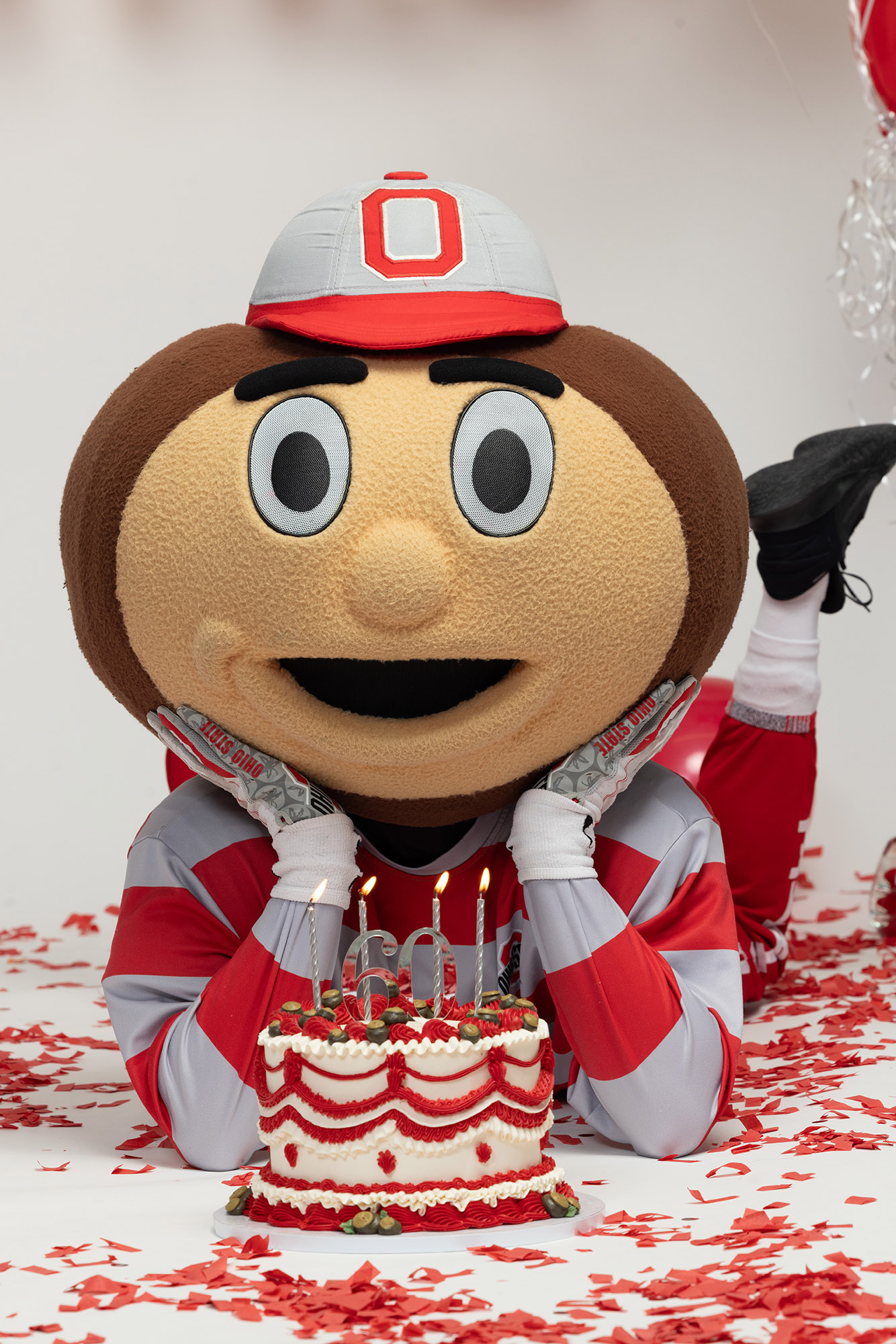
A boost for Brutus students
Celebrate Brutus’ 60th birthday by supporting scholarships for students who wear the Brutus Buckeye suit. They’re not just performers, as the Buckeye Funder campaign says. They’re ambassadors of the energy, spirit and excellence that define Ohio State.

